The Kinross Incident

On the cold evening of November 23, 1953, a fighter jet disappeared without a trace over the icy waters of Lake Superior. The jet was on a mission to intercept an unidentified aircraft. Within moments of nearing the target, the interceptor seemed to vanish. Despite extensive search and rescue efforts, no trace of the jet or its crew was ever found.
This incident, occurring during the Cold War era, was ripe for speculation, conspiracy theories, and a myriad of interpretations. Over the decades, the story of the Kinross Incident has been retold, with details morphing and evolving, making it even more enigmatic. Yet, amidst the swirl of rumors and inconsistent reports, what truly happened that night remains a question without a definitive answer.
In this article, we'll embark on a journey to uncover the facts, dive into the mysteries, and explore the various theories surrounding the disappearance of the aircraft.
Warning: This article attempts to provide as much relevant detail as possible. There is a significant amount. If you would rather read a short summary of the incident, go here: LINK TO VISIT KEWEENAW ARTICLE
Disclaimer: This article aims to give a fair overview of the Kinross Incident. We've used sources that we believe to be reliable, but due to the event's age and nature, we can't confirm every detail. We're not pushing any specific theory; we're just presenting the facts as we found them and occasionally providing our own analysis. Readers are encouraged to form their own opinions.
BACKGROUND INFORMATION
In the early 1950s, as tensions escalated between the United States and the Soviet Union, marking the onset of the Cold War, there was a swift expansion of the U.S. domestic air defense. This period witnessed the establishment of numerous Air Force bases and radar stations, forming the initial phase of the country's air defense strategy. At the time of the Kinross Incident, this nascent defense system had only been operational for a short span and was still in its rudimentary stages.

The 30th Air Division, organized in February 1953, was tasked with the mission of air defense of the upper Great Lakes region of the United States. Under the 30th AD was the 4706th Air Defense Wing, under which were several entities involved with this incident, including:
- 30th Air Division Headquarters at Willow Run Air Force Station, callsign “HORSEFLY”
- 665th AC&W Squadron at Calumet Air Force Station (then known as Keweenaw Radar Site), GCI callsign “PILLOW”
- 753rd AC&W Squadron at Sault Ste Marie Air Force Station, GCI callsign “NAPLES”
- 534th Air Defense Group at Kinross Air Force Base
- 438th Fighter Squadron at Kinross Air Force Base
- 520th Air Defense Group at Truax Air Force Base (then known as Truax Field)
- 433rd Fighter Squadron at Truax Field
In mid-October 1953, the 438th Fighter Squadron from Kinross went to gunnery training in Arizona and didn’t come back until December 1953. While they were away, the 433rd Fighter Squadron from Truax Air Field took over and maintained alert at both Truax and Kinross simultaneously for over a month.
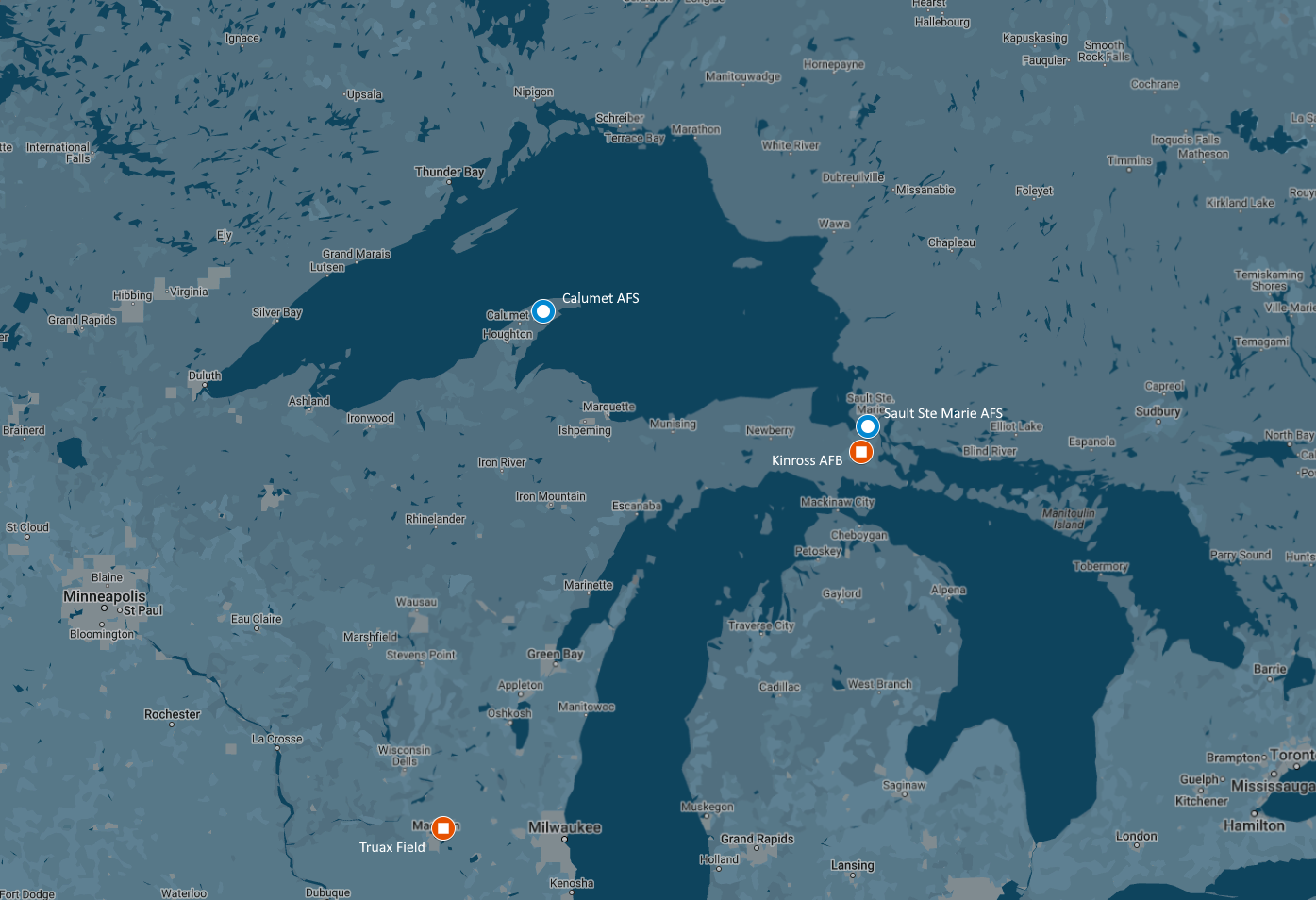
NOVEMBER 23, 1953
Monday, November 23, 1953 began like a typical day at Kinross AFB. The weather was chilly and overcast, with a low over northern Minnesota moving a cold front east towards Michigan. The 433rd Fighter Interceptor Squadron was operating with four interceptor aircraft on alert status: two on 5 minute alert and two on 15 minute alert. F-89C Scorpion serial number 51-5853A was given a pre-flight inspection at 7:30AM local time in preparation for alert duty. The pre-flight inspection found no discrepancies and the aircraft was moved to the alert hangar where it was set to number one aircraft on 5 minute alert status. In the event an aircraft needed to be scrambled, this F-89C could be airborne in five minutes or less.

At approximately 11:45AM, aircraft 51-5853A was scrambled and returned to base at approximately 12:45PM. The pilot recorded in his report that the flight was “OK” and the aircraft was given the standard post-flight service. Once serviced, the aircraft was moved back to the alert hangar and returned to number one position on five minute alert status.
By evening, the eastern half of Lake Superior was covered in clouds with a layer of stratocumulus from roughly 3000 feet to 8000 feet, and another layer of altostratus from 10,000 feet to 14,000 feet. There were scattered snow showers throughout the area. Visibility was generally 8 to 10 miles but could be as low as 1 to 2 miles in the patches of snow showers.

6:17PM | Radar operators at PILLOW detected an aircraft over Lake Superior1. According to the official statement by Second Lieutenant Douglas Stuart, the GCI controller at Calumet AFS, the aircraft was believed to be a C-47 Dakota of the Royal Canadian Air Force identified as VC-912. The aircraft was traveling across Lake Superior from Winnipeg to Sudbury. 2 The flight path would have taken the plane from west to east across the northern portion of Lake Superior, well within the Canadian border. However, because the aircraft was about 30 miles off course it was classified as “Unknown”. 30th AD headquarters at HORSEFLY wanted the aircraft positively identified and sent word to NAPLES, who then ordered Kinross AFB to scramble a five minute alert aircraft. Aircraft 51-5853A was the first in line and took off at 6:22PM with First Lieutenant Felix Moncla, Jr as the pilot and Second Lieutenant Robert Wilson as the radar operator. The aircraft was given the callsign “Avenger Red” and it set off on a heading of 300 degrees at 30,000 feet.3 NAPLES had GCI control of the flight at this time.
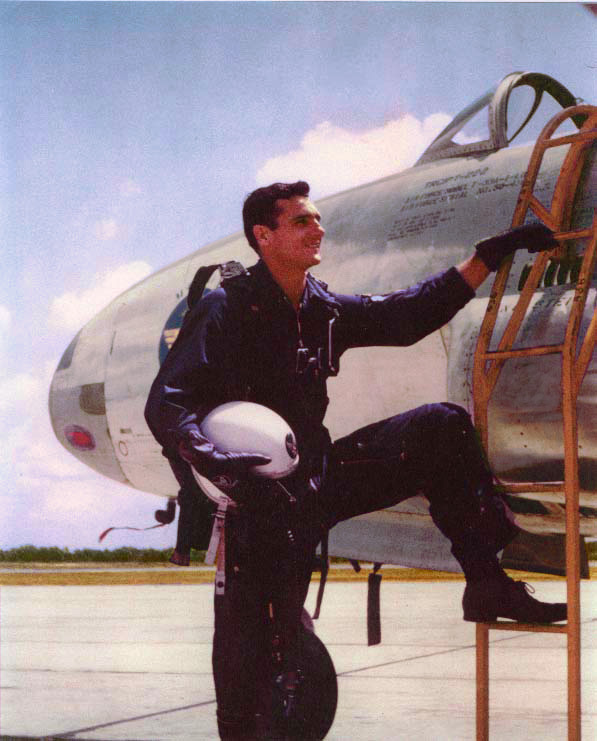
6:35PM | NAPLES reported poor radio reception with Avenger Red and attempted to pass GCI control over to PILLOW. Signal was very poor so NAPLES retained control for the moment. At 6:41PM control was handed over to PILLOW with marginally better radio signal. At 6:45PM Avenger Red asked if the intercept should be called off due to the poor radio signal, and was informed that they should proceed at their own discretion.
Despite the poor radio signal, both PILLOW and NAPLES maintained a strong, clear radar return from Avenger Red throughout the flight. This would have been the return signal reflected back off of the F-89C by the search radars at both sites. In addition to this, the F-89C had an Identification, Friend or Foe (IFF) transponder that would send a response signal of its own when interrogated by the ground radar stations.
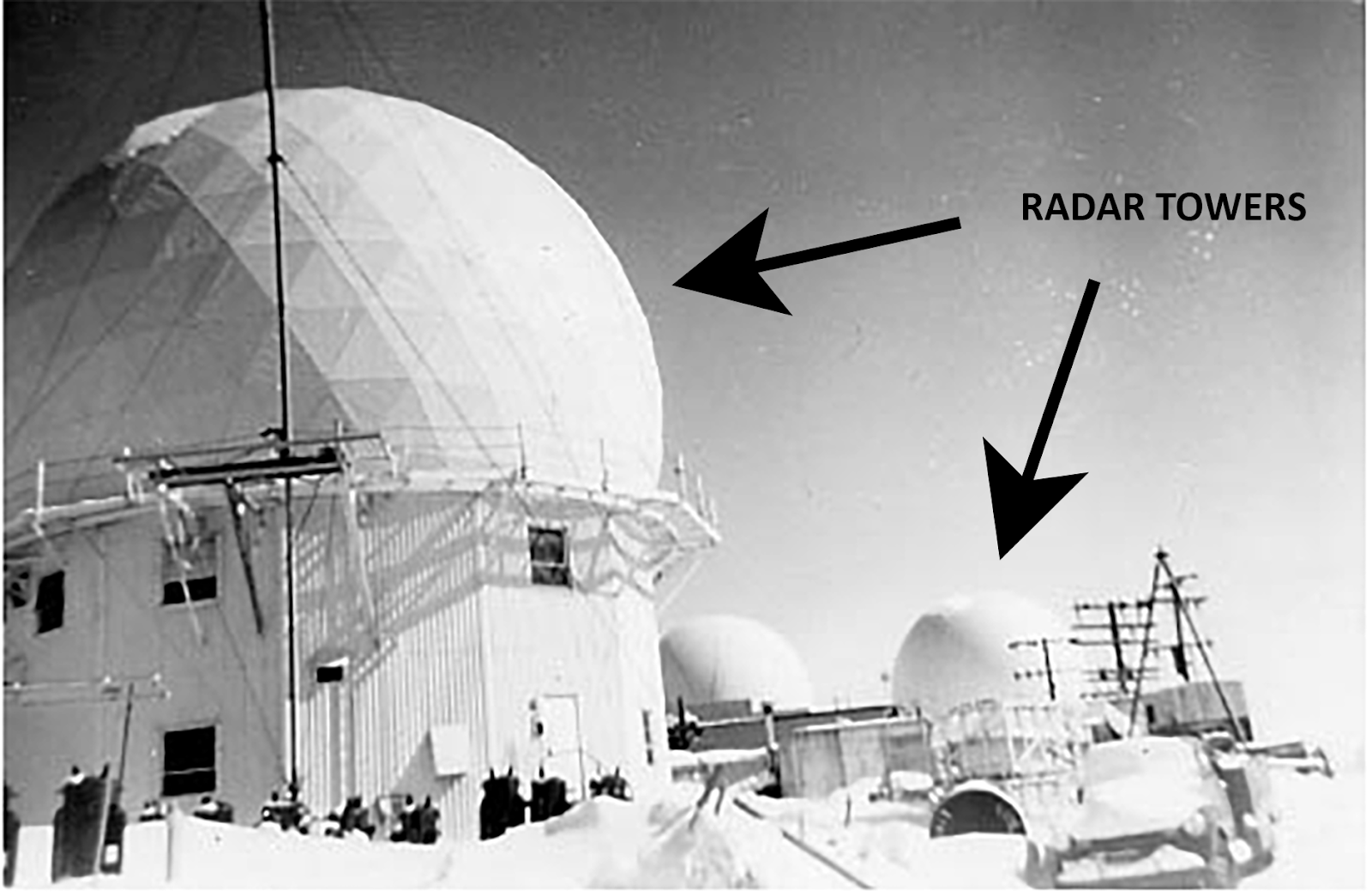
6:47PM | PILLOW directed Avenger Red to adjust heading left to 270 degrees and begin descending to 7000 feet in preparation for the intercept. Two minutes later at 6:49PM Avenger Red requested “Pigeons to Home” (aka heading and distance back to Kinross AFB) and was given “150 - 125 miles” by PILLOW.4 The aircraft was passing through 25,000 feet at this time.
6:51PM | PILLOW directed Avenger Red to adjust heading right to 20 degrees to intercept the target.
6:52PM I Avenger Red was informed that their target was at their 11 o’clock position, 10 miles out. Pilot Felix Moncla, Jr acknowledged this. PILLOW gave another range and heading report but did not receive a response. They also informed Moncla that the target would be moving from left to right (west to east) and if he didn’t see it on the first attempt they were set up to make another pass, but this was also not acknowledged.
At 6:55PM, the radar blip for Avenger Red converged with the unknown target to form a single dot on the radar screen. The GCI controller at PILLOW watched, waiting for the two dots to separate on radar, thinking that Avenger Red had possibly pulled in near the target and was flying formation with them. However, shortly after the two blips merged on radar, the IFF signal from Avenger Red was lost. Repeated calls from PILLOW to the pilot also went unanswered. PILLOW then reached out to NAPLES and advised them to try contacting Avenger Red, but they also reported no success. The last known position of Avenger Red was 48.00N 86.49W.
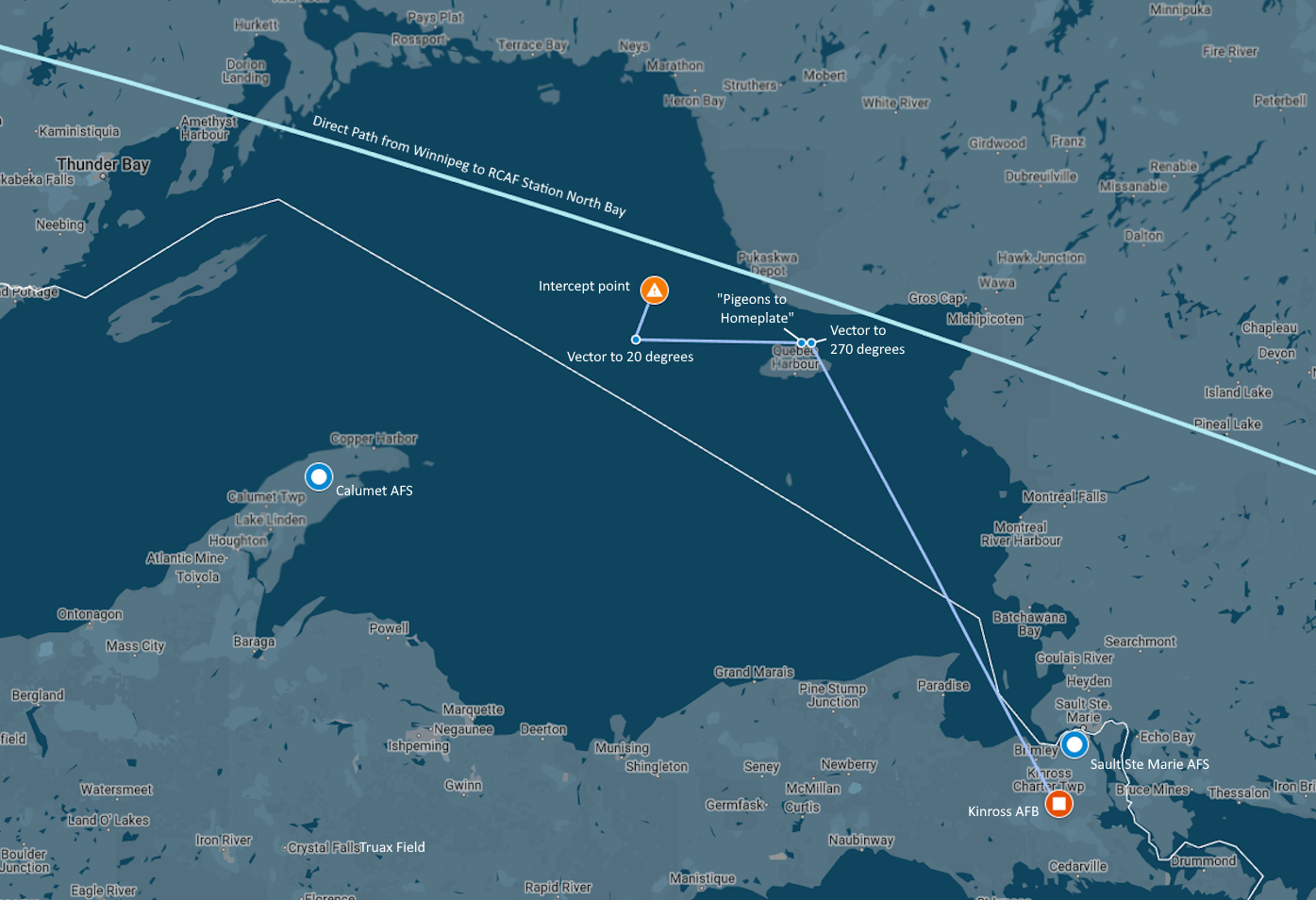
Back at Kinross AFB, Lieutenant William Mingenbach had been in the second F-89C on five minute alert status. Both aircraft were almost at the point where they would be relieved by the 15 minute alert crew when Moncla’s had been scrambled at 6:17PM. Shortly after takeoff, the two 15 minute alert aircraft took over 5 minute alert status and relieved Lt Mingenbach. The new F-89C in the primary 5 minute alert role was piloted by Second Lieutenant Howard R. Nordeck. At 6:25PM Mingenbach left for dinner and returned to his aircraft about 7:00PM. At this time he radioed NAPLES and requested permission to go on a Combat Air Patrol (CAP) mission. Permission was granted and by 7:15PM his aircraft was airborne. At 7:18 he contacted NAPLES by radio and was directed to vector to heading 330 degrees at an altitude of 20,000 feet. Their call sign would be Avenger Black. It was only at this point that Mingenbach learned that Avenger Red had disappeared from radar and was unable to be contacted via radio. Their orders were to approach the last known location of Avenger Red and attempt to contact them by radio, hoping that the signal was just being lost due to the weather and a nearby aircraft would be able to get through easier.
During the climb to 20,000 feet Avenger Black encountered several layers of cloud cover from 5,000 feet to 20,000 feet and requested to change altitude to 30,000 feet where the sky was clear. At about 7:35PM on heading 330 degrees at approximately 25,000 feet of altitude, both Lt Mingenbach and his radar operator believed they heard a short radio transmission from Avenger Red, claiming they both recognized the sound of Moncla’s voice. The transmission only lasted about five seconds and sounded like it was in the middle of a sentence so the meaning of the transmission was unclear. Several attempts to contact Avenger Red by radio went unanswered. Shortly after this Avenger Black was directed to adjust heading left to 270 degrees and GCI control was passed from NAPLES to PILLOW.
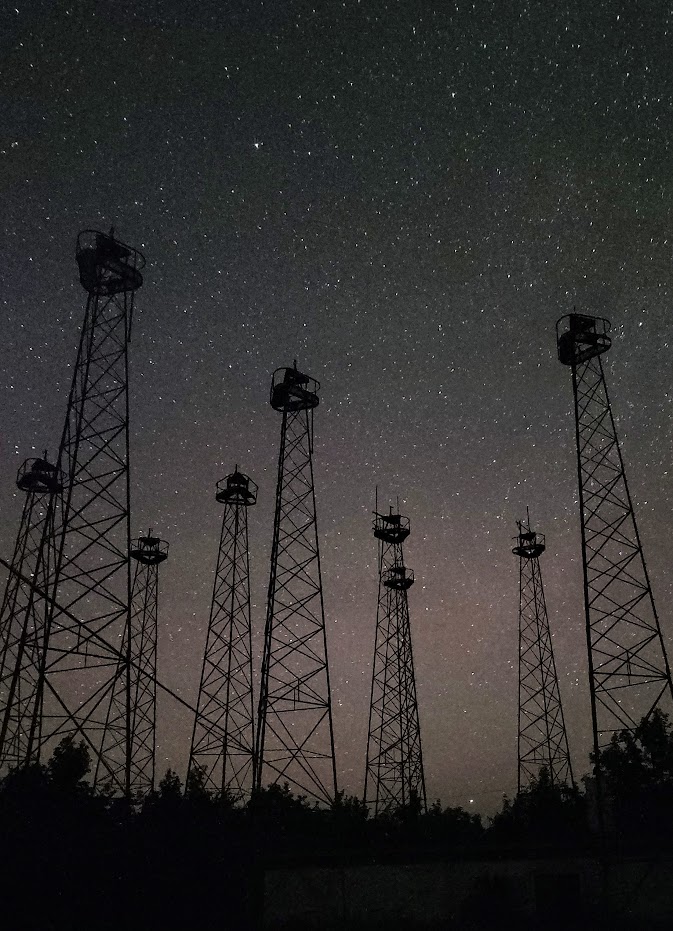
PILLOW directed Avenger Black to the last known location of Avenger Red and requested he move to a lower altitude to investigate. However, the weather report at Kinross had forecast moderate to heavy icing in the lower altitudes for this region and the F-89C flown by Avenger Black was not equipped with retractable engine screens, so there was a risk that they could ice over in poor weather conditions. The low cloud ceiling and snow showers in the area would have also made a visual search difficult. They were instructed to circle the area and wait.
7:42PM | NAPLES scrambled another five minute alert aircraft to aid in the search. Second Lieutenant Nordeck and his radio operator were airborne by 7:46PM and were given the call sign Avenger Purple. They were directed to climb to 20,000 feet and vector to heading 320 degrees. NAPLES inquired if their aircraft had retractable engine screens, and when Nordeck confirmed that it did he was informed that he would also be traveling to the last known location of Avenger Red, attempting to make radio contact, and descending through the clouds to check for icing conditions and to attempt to locate the aircraft. Avenger Purple also encountered layers of cloud cover during their climb and requested an altitude change to 30,000 feet which was granted. With Avenger Red, Avenger Black, and Avenger Purple all airborne, there is only a single remaining aircraft on alert status at Kinross AFB.
8:07PM | Avenger Red would have been completely out of fuel. It’s at this point that 433rd Fighter Interceptor Squadron Officer In Charge (OIC) Captain William Bridges notified Base Operations and the Kinross AFB Commanding Officer (CO) that they had an overdue aircraft. When all attempts to contact Avenger Red had failed, NAPLES directed Avenger Black and Avenger Purple to return to Kinross AFB. Avenger Purple was approximately 120 miles from Kinross AFB at the time and had not yet reached the last known location of Avenger Red. Avenger Purple lands at 8:50PM with Avenger Black five minutes later at 8:55PM.
9:50PM | Captain Bridges was advised by the base CO that he should personally fly to the point of last contact with Avenger Red. He took off under GCI from NAPLES but only made it 75 miles from Kinross AFB before he had to turn back due to snow, low cloud ceilings, and loss of radar and radio contact.

Discrepancies:
1 Many articles and websites that discuss this incident incorrectly state that the unidentified aircraft was first detected in restricted airspace near the Soo Locks, on the eastern end of Lake Superior. There is no mention of this in any of the official Air Force documents or any newspaper articles released at the time so it is unknown where this detail came from. It doesn’t match up with any of the known information, and the fact that PILLOW was the station that reported the aircraft would seem to confirm it was instead somewhere on the western end of Lake Superior.
2 It’s not exactly clear where this aircraft was heading if Sudbury was listed as the destination (actually spelled “Sudberry, Canada” in the report). The commercial airport in Sudbury, ON did not open until 1954 and was still under construction in 1953, though the site did serve as an emergency landing facility. The nearest Canadian military base with a runway was RCAF Station North Bay which was about 75 miles to the east. Several websites discussing this incident incorrectly state that the Canadian C-47 was destined for Sault Ste Marie, but this is not mentioned in any of the reports and would be impossible since neither the American or Canadian side of Sault Ste Marie had an airport in 1953.
3 This initial heading of 300 degrees is given in the official report, but doesn’t seem to make sense. If all of the following course adjustments given are accurate, an initial heading of 300 degrees would put the final known location of the F-89C much further south in the lake, nowhere near the last known position. An initial heading closer to 330 degrees would make much more sense and lines up with the rest of the known course changes. This also matches up with the main runway at Kinross AFB which would put aircraft on a 337 degree heading if they took off to the north.
4 The response of “150 - 125 miles” means that Kinross AFB was to the south-east of Avenger Red at 150 degrees and 125 miles away. This would put the F-89C directly north of Michipicoten Island on the north-east shore of Lake Superior, well into Canadian airspace. If this is accurate, then the initial heading of Avenger Red was close to 330 degrees (or the aircraft drifted east during the first leg of the flight)
SEARCH AND RESCUE
At 10:00 pm the same day, 3 hours after the disappearance of Avenger Red, the Eastern Area Rescue Coordination Center in Ontario was contacted by the USAF 49th Air Rescue Squadron to coordinate the search and rescue efforts. Due to extremely bad weather existing between their headquarters in Trenton, Ontario and Kinross AFB, they were unable to depart until the following morning. Prior to the arrival of the Canadian searchmaster and their aircraft, the US Coast Guard provided an SA-16 aircraft and a surface vessel, the USCG Woodrush. The 49th Air Rescue Squadron provided two additional SA-16s and together they carried out an expanding square search the night of the disappearance and the following day.

The initial search blocks were laid out to cover 60 miles west of the last reported position eastward. The other jet crews from Kinross who initially searched for Avenger Red gave the opinion that normally a missing pilot’s first move would be to turn towards home base at any sign of trouble, which was given to Moncla as 150 degrees. With this in mind, further search blocks were extended out to the east and south. After this initial search, no further night search was carried out because of bad weather and lack of emergency equipment carried by the crew of Avenger Red. The only equipment they would have had was a small emergency raft for each person.

In the following days, a slew of aircraft from all over joined the search. The 49th Air Rescue Squadron provided two SA-16s, four C45s and a B25; Kinross provided one C47 and a helicopter; the US Coast Guard at Traverse City provided an SA16, the Civil Air Patrol provided a Cessna 140; the Royal Canadian Air Force provided four C47s. These follow up searches were constantly hampered by bad weather, with some search aircraft being iced over while still on the ground in one instance.
Aerial searches were conducted from an altitude of 1000’ with 2 miles of visibility. Aircraft flew along the coasts from Sault Ste Marie to Marquette and back, and from Sault Ste Marie to Simpson Island and back, all at an altitude of 500’. Several possible clues were obtained from the public that were considered worthy of investigation.
On November 25 a mail carrier reported seeing the wreckage of an aircraft in the water near the Cut River Bridge about 35 miles southwest of Kinross AFB on the Lake Michigan shore. Michigan State Police searched the area three times without finding anything, and dismissed the sighting as simply rocks. On November 27 there was a report of aircraft wreckage on a mountainside in the Canadian wilderness about 80 miles north of Kinross AFB. The area was searched exhaustively by three planes and a helicopter without finding anything. A third clue was received around this time from someone near the town of Limer, Ontario that reported seeing a low flying aircraft on the night of the 23rd, though the time did not match up with the disappearance of the F-89 so it was not investigated.

On November 28, 1953 the search was officially suspended. The search teams reported covering 80% of the designated search area without a single trace of the missing aircraft or crew found.
In April of 1954, the 49th Air Rescue Squadron received word that there were possible new clues to the location of the missing F-89. Apparently the witness who had seen a low flying aircraft near Limer, ON on the night of November 23rd claimed that he may have been mistaken about the time he saw the aircraft and it could have been closer to when the F-89 disappeared. The father of the missing radar operator onboard Avenger Red had contacted the headquarters of the 5th Air Rescue Group to resume the search in this area. Headquarters then reached out to the 49th Air Rescue Squadron and with this new information plans were made to send aircraft to the area. At the time, the snow in the area was still two to four feet deep, so the search was planned for mid May. As of this time we cannot find any documents that state the results of this search, but it is presumed they found nothing. This section will be updated when we can find more conclusive information.
On October 29, 1968, two prospectors in the area near Cozen’s Cove and Alona Bay, Ontario discovered wreckage of an unknown aircraft on the shore of Lake Superior. The only information we have about this discovery at the moment are two articles from the Sault Daily Star from October 30 and 31st of that year, so details are fairly limited. These articles claim the debris was a piece of an aircraft tail section that had washed up on the beach roughly 70 miles north of Kinross AFB. The article describes the piece as bare metal with no paint remaining except some flecks of yellow primer and an unknown maroon color that could have been due to discoloration from heat or the weather. It’s described as “a heavier metal than normally used in aircraft” and the Canadian Provincial Police apparently identified the parts as military parts. The article also claims that a Maj. J. H. Parker of the USAF at Kincheloe Air Base (formerly Kinross AFB) identified the stabilizer on the tail section as belonging to a high performance military jet aircraft. However, the article abruptly ends by stating “Earlier there was some conjecture it could have been wreckage from an F-89 Scorpion interceptor downed in 1953 but this later appeared unlikely”. There is no explanation for why it appeared unlikely to be the F-89 though, and as of now we can find no other reliable sources that discuss this finding or provide any additional details. It is unknown where this wreckage is now.

GREAT LAKES DIVE HOAX
In 2006, a man named Adam Jiminez from the Great Lakes Dive Company made an astonishing claim - his company had discovered the wreckage of what could only be the missing F-89! He claimed that their company had been hired to perform salvage work on the shipwreck Gunilda but had been unable to do so due to equipment and weather issues, so they decided to use their sonar equipment to search for the missing aircraft instead. He claimed they found the jet resting on the bottom of the lake in about 500’ of water and even posted a sonar image of the aircraft. One wing was completely missing but it was otherwise intact, and they even claimed the canopy was still closed. Furthermore, they claimed there was an unknown metallic object half buried in the lakebed nearby. The claims about this discovery quickly gained a lot of attention, particularly among UFO and paranormal websites which seems to be the only place they were actually posted.
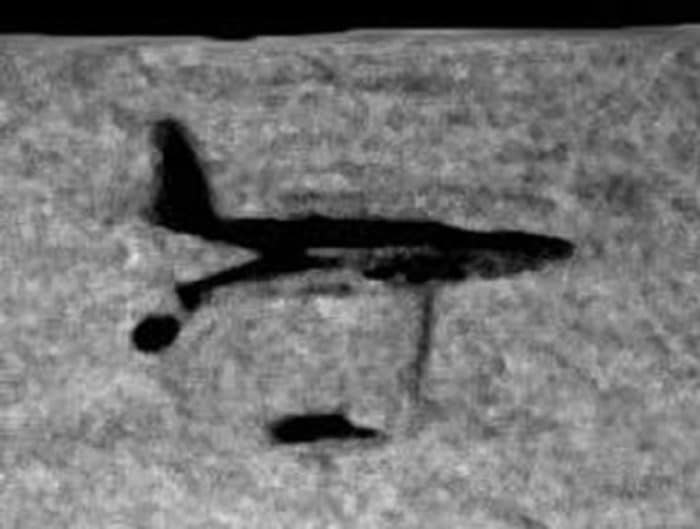
However, skeptics soon started to raise questions. Brendon Baillod, a Great Lakes maritime historian, researcher, and archivist had serious doubts about many of the claims made by Adam Jiminez. He had extensive connections throughout the diving and maritime salvage community in the Great Lakes area, and neither he nor anyone he spoke to had ever heard of Adam Jiminez or the Great Lakes Dive Company. No one was able to find a company registered under that name either. He did not believe the sonar equipment they claimed to have used could have produced the images they released and he had doubts about the methods they claimed to use in their story. He did believe the images were authentic though, but likely taken from Air Force archives of a different crash. Furthermore, he even went so far as to claim he believed the real “Adam Jiminez” was a 46-year-old Air Force employee from Oscoda, MI but didn’t provide any further identification. Right around this time the website for the Great Lakes Dive Company was taken down, and the man going by Adam Jiminez vanished without a trace.
UNCLEAR EVIDENCE AND DEBATED EXPLANATIONS

Up to this point in this article, everything has been compiled from as many official sources as possible. The story paints a picture of an unfortunate accident where some type of failure caused the F-89C to crash into Lake Superior during the interception of the bogie. Bad weather typical of Lake Superior in November hampered any recovery efforts and the pilot and radar operator were considered KIA.
So what is the conspiracy behind this incident and where did it come from? Why did this incident become associated with UFO stories? There are seemingly more UFO researchers and websites that discuss the event than any other source, and they all have varying accounts of what happened. Some say the unidentified aircraft was first spotted near the Soo Locks, some say the F-89 Scorpion actually chased the UFO across the lake, some give different accounts of the radio transmissions between the pilot and GCI controllers, and some imply that the UFO disappeared off the radar shortly after the two dots merged. The origin of some of these details are completely unknown, and may simply be embellishments to add more mystery or excitement to the story.
Donald Keyhoe - The Source of Many Discrepancies?
It appears that a good number of these otherwise unsupported claims can all be traced back to the account of the incident published in the book The Flying Saucer Conspiracy by Major Donald Keyhoe in 1955. Major Keyhoe was a prominent UFO researcher and writer during the 1950s, 60s, and 70s and published numerous articles and books on the subject.
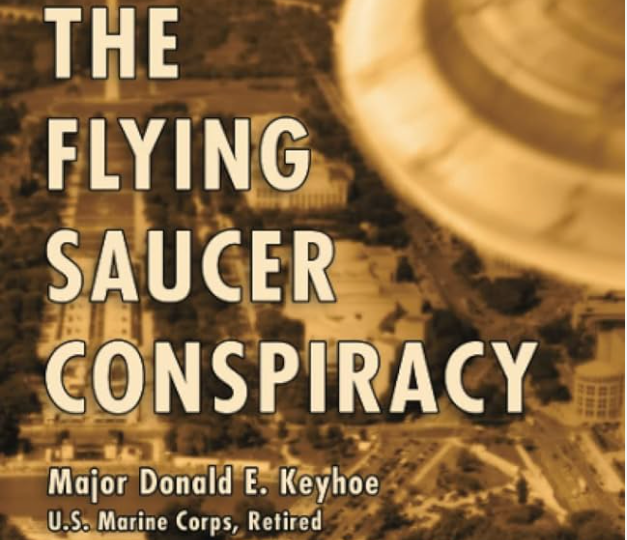
Here we will look at some excerpts from the book and analyze his story.
It was the evening of November 23, and wintry darkness had settled over Michigan. At an isolated radar station Air Defense Operators were watching their scope in a routine guard against possible enemy attack.
Suddenly the “blip” of an unknown machine appeared on the glass screen. The Ground Control Intercept office took a quick look. The “unknown” was flying over the Soo Locks– and no aircraft was scheduled near that important target. Whatever it was, it had to be identified swiftly.
In less than two minutes an F-89 from Kimross Field was streaking toward the locks. At the jet’s controls was Lieutenant Felix Moncla Jr., a veteran at 26. Behind him was Lieutenant R.R. Wilson, 22-year-old Oklahoman, acting as radar observer. Guided by Ground Control, Moncla climbed steeply toward the “unknown”.
Immediately, certain aspects of this narrative appear unusual. Sault Ste Marie Air Force Station, known by the Ground-Control Intercept (GCI) callsign NAPLES, was situated only about 3.5 miles from the Soo Locks. Given that this station was equipped with radar capable of detecting objects over 200 miles away, it seems puzzling how an object could suddenly appear in the middle of their observable airspace. Additionally, it's worth noting that the name 'Kinross' is consistently misspelled as 'Kimross' in the book.

Back at GCI, the controller watched the jet’s blip on his glowing radarscope. As it moved toward the UFO’s blip, the strange craft changed course. The controller called Moncla, gave him the new bearing. From the scope he saw that the F-89 was now over Sault Sainte Marie, though to the crew the city’s lights would be only a blur, quickly lost behind.
The UFO, flying as fast as a jet airliner, was heading toward Lake Superior. At over 500 miles per hour, the F-89 raced after it, out across Whitefish Bay. Nine more minutes ticked by in the tense quiet of the GCI radar room. Gradually the F-89 cut down the gap. By now, the controller knew, Wilson should have spotted their quarry on the fighter’s short-range radar. Watching the chase, he cut in his microphone and called the flight’s code name.
Several points here merit closer analysis. First let’s examine this sentence: The controller called Moncla, gave him the new bearing. From the scope he saw that the F-89 was now over Sault Sainte Marie. It is noted that Moncla was given a new bearing while the F-89 was over Sault Sainte Marie. The Soo Locks are located immediately adjacent to the small border cities of Sault Ste. Marie in Michigan and Canada. Taking into account the fighter jet's maximum speed, it would require at least two minutes to reach the city, plus additional time for the initial scramble. This implies that the UFO would have to stay in the vicinity for about 4-5 minutes, essentially hovering over the city. Such a detail, if true, would be significant enough to warrant mention in Keyhoe’s story, yet its absence is notable. Additionally, this situation implies that the fighter jet might not have approached at its top speed due to the short distance involved, potentially extending the time it took to reach the city. At maximum speed, an F-89 can cover the distance across both cities and the Soo Locks in under a minute.
He further states: The UFO, flying as fast as a jet airliner, was heading toward Lake Superior. At over 500 miles per hour, the F-89 raced after it, out across Whitefish Bay. Records show that the F-89 Scorpion could fly at a top speed of 450 knots (~517mph) at 35,000ft altitude. Unfortunately due to structural issues, the fighters needed modifications which left them only able to fly at ~80% of the performance potential, less than 500mph. The later F-89Ds with afterburners were however reported to have top speeds of ~600mph. There is also the issue of fuel, which would have been exhausted extremely rapidly at top speeds. Perhaps we are looking at his words too pedantically.
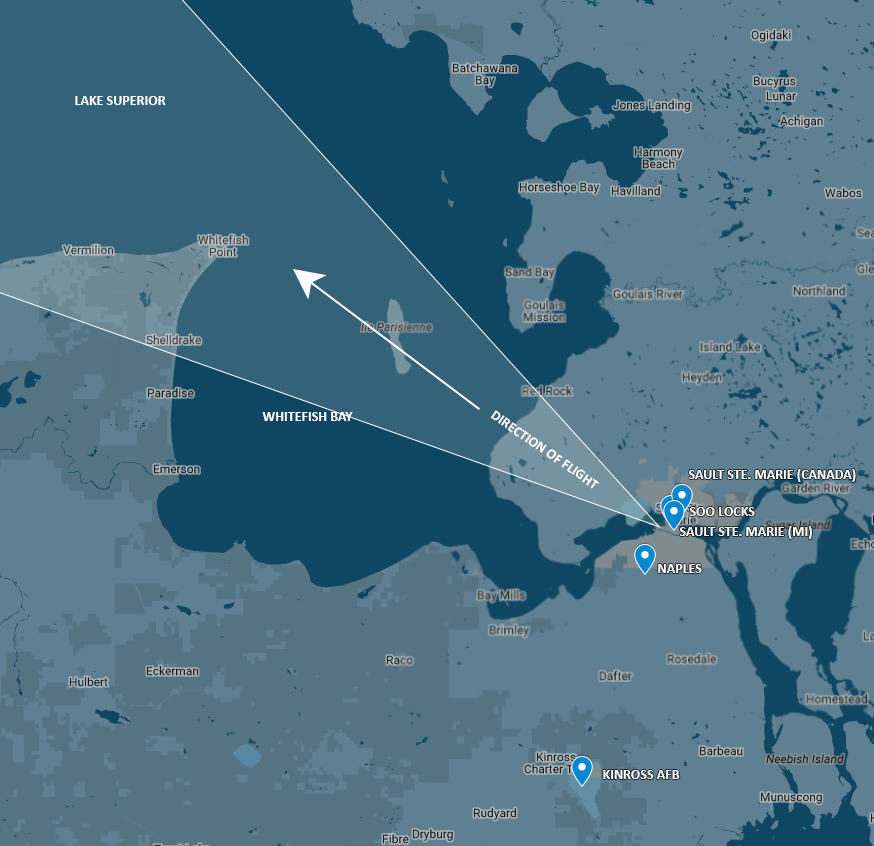
“Target should soon be visual. Still bearing —-”
He broke off, staring at the scope.
The two blips had suddenly merged into one.
Whether the strange machine had abruptly slowed or Moncla unaccountably had put on full power, no one in the room could tell.
But one thing seemed grimly certain: the two machines were locked together, as if in a smashing collision.
Keyhoe's account here reveals a misunderstanding of radar technology, particularly its early iterations in the 1950s. During that era, radar resolution was relatively low, causing targets in close proximity to merge on the radar screen. This phenomenon of blips merging does not necessarily indicate a physical collision. A more detailed explanation of this concept is provided in a later section of this article.
For a moment longer the huge, ominous blip remained on the glass. Then it quickly went off the scope.
Marking the position, the controller flashed word to Search and Rescue. Moncla and Wilson might have bailed out in time. Both had life jackets and self-inflating rafts; even in the icy water they might survive for a little while.
This is the first account we see of the blip disappearing off radar. The official report claims it continued on its original flight path undeterred.
The book progresses by detailing Keyhoe's interactions with Air Force personnel and his subsequent analysis. His account significantly diverges from the official Air Force version. These discrepancies appear to be a primary source of the inconsistencies found when compared to official Air Force documents. However, there are other elements beyond Keyhoe that further cast doubt on the credibility of the official report.
Why Didn’t They Contact The Canadian C-47?
The question arises: if the aircraft being intercepted was indeed a Canadian C47, why was there no initial attempt to communicate with it before dispatching the fighter jets? The official report indicates that the pilot was contacted afterward to inquire if they had noticed the fighter, suggesting that there were means for communication. A plausible explanation is that the Air Force was seizing opportunities for training exercises. Reports from that time even quantify total interceptions as a metric to be achieved. The accident report for the Kinross Incident mentions that the same aircraft involved had been scrambled for another mission earlier on the same day.
This perspective is further supported when considering the new RADAR and IFF systems installed at Calumet Air Force Station (“PILLOW”) earlier that year, and similar updates likely at other radar stations. Additionally, the F-89Cs had recently undergone significant rebuilds. These factors combined indicate a strong motivation for the Air Force to maximize practice opportunities. In fact, the report from Calumet Air Force Station (“PILLOW”) during the time of the incident specifically mentions a shortage of intercepts, leading to the need for Controllers to be sent to other stations to fulfill their operational requirements.

In 2004, researcher Gord Heath, delving into the details of the Kinross Incident, established communication with Gerald Fosberg, who claimed to have been the pilot of the C47 that was allegedly the target of the interception. Fosberg, who served with the 412th Squadron at Rockcliffe, asserted his role in the events of that night. Below is an excerpt from the letter he sent in response to Heath's inquiry.
I remember the flight reasonably well, and just checked my log books to confirm the date. It was a night flight. We were probably at 7,000 or 9,000 feet over a solid cloud deck below and absolutely clear sky above.
Somewhere near Sault Ste. Marie, and north of Kinross AFB, I think a ground station (can't remember whether it was American or Canadian) asked us if we had seen another aircraft's lights in our area. I do think I recall them saying at that time that the USAF had scrambled an interceptor and they had lost contact with it. We replied that we had not seen anything. A few days later I received a phone call from somebody at Kinross who was carrying out an investigation on a missing aircraft. I could only tell them that we had seen nothing. That was the last I ever heard of the incident.

The pilot's account aligns with the official report, confirming that the C-47 was not contacted until after the fighter's disappearance. In a separate discussion, Gord Heath reports that Gerald Fosberg insisted his plane was on a direct course from Fort William to Sault Ste. Marie and was never off course. This course would have placed them well away from the location where the F-89 vanished, though the initial 300-degree heading mentioned in the official report seems more consistent with the event.
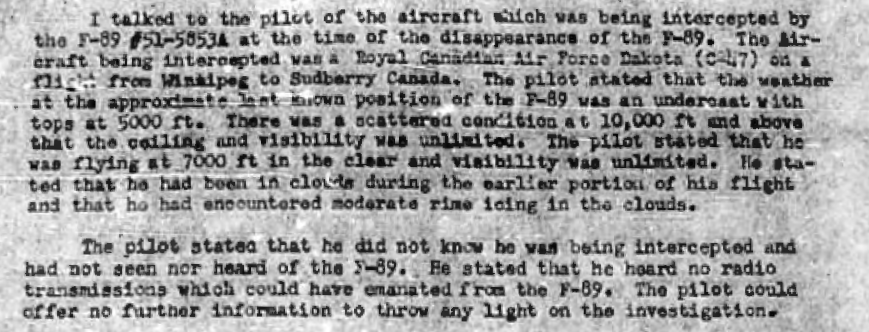
Adding another layer to the mystery, numerous reports suggest that the Royal Canadian Air Force stated they had no aircraft in the vicinity during the incident. While our investigation has not found clear evidence of such statements, there is a notable declaration indicating that they never had a plane "intercepted." This could be accurate if the alleged interception did not actually occur because the F-89 crashed prior to reaching the C-47.

Other Minor Discrepancies
There are allegations that the Air Force provided differing accounts to the family of Felix Moncla regarding his fate. In one instance, it was reported that the jet crashed into Lake Superior, while in another, a different group reportedly informed the family that the jet exploded midair. However, we have not been able to find reliable sources to substantiate these claims, though our search continues.
There are also claims that the Air Force said Felix Moncla suffered from Vertigo. Again, we cannot find any official source of the claims yet. If they are true, it would be unusual because the official accident report claims that no medical issues were a factor in the crash.
There are many other small claims about various details of the incident that we have not included here. As we continue our research and find sources, we will add them to this section.
TECHNICAL PERSPECTIVES
In our extensive research to gather comprehensive details about this incident, we have compiled a significant amount of technical information that we believe is highly relevant to the story. The following sections will delve into this content.
F-89 SCORPION FIGHTER JET
The Northrop F-89 Scorpion was the first American jet aircraft to be specifically designed and designated as an interceptor aircraft. It officially entered service with the US Air Force in September of 1950. Only 18 of the initial version, the F-89A, were completed before the upgraded F-89B was introduced in June of 1951. Unfortunately, both the F-89A and F-89B were plagued by engine failure issues. The F-89C quickly followed in September of 1951 with an upgraded engine, but the problems continued. In addition to reliability issues with the engines, their low placement on the aircraft also had a tendency to suck up debris off of the runway during taxiing, takeoff, and landings. Engine screens were added to prevent this, but the screens were found to cause their own problems when they would clog up with ice at high altitudes. These were eventually replaced with retractable engine screens that could be deployed on the ground and retracted once in the air. Starting in 1952, an even more serious problem was discovered with the F-89. Between February and September of that year, a series of six F-89 aircraft all had disastrous mid-air disintegrations during aerial maneuvers. Investigations pointed to poor aircraft stability and possible structural fatigue causing the aircraft to literally break apart during the stress of maneuvers. Most of the aircraft involved were the F-89C model.

On September 22, 1952 all F-89 aircraft in use were grounded until necessary modifications could be made to fix the structural and stability issues. The problem was attributed to a faulty design in the wing structure, and would need to be addressed before any F-89 could be deemed flightworthy again. This required a complete redesign of the aircraft and a modification made to all existing aircraft. Even then, modified aircraft were still limited to a maximum of 80% of their actual performance potential. They especially had issues at lower altitudes, and were restricted to a maximum speed of 425 knots at altitudes less than 20,000’. At the same time, the F-89 continued to have engine problems at higher altitudes, with noticeable decreases in engine power under certain conditions at altitudes greater than 30,000’. Furthermore, the structural improvements were not included from the factory until the F-89D, so all F-89Cs (including 51-5853A flown by Felix Moncla, Jr) had to be modified after leaving the factory. The F-89C was deemed obsolete by 1954 when it was completely replaced by later models.

There were several notable crashes around the same time as the Kinross Incident, all involving aircraft from the 433rd Fighter Interceptor Squadron from Truax Field. On August 3rd, an F-89C that was on temporary assignment in Yuma, AZ had to make an emergency landing after experiencing a severe vibration in the engines. During the landing, the brakes failed to stop the aircraft and it ran off the end of the runway before the nose landing gear collapsed. The pilot was uninjured. On November 3rd, an F-89C from the 433rd FIS collided with an F-86D from the 432nd FIS. The pilots of both aircraft were able to bail out, but the radar operator of the F-89C died after ejecting.

Then on November 23rd, only a few hours before Felix Moncla, Jr and Robert Wilson disappeared with their F-89C, another F-89C from the 433rd FIS had crashed and exploded near Madison, WI. Pilot 1st Lieutenant John W. Schmidt and radar operator Captain Glen E. Collins were on a routine training mission out of Truax Field in Wisconsin when their aircraft suddenly nose-dived into the swamp around Lake Wingra. One report states they were on an operational flight to check the afterburners on the newly installed J-35-A-47 engines. The aircraft had been flying at 40,000 feet before being observed in a steep dive and ejecting the canopy immediately before impact with the swamp. The aircraft exploded on impact, leaving a 50’ diameter crater in the swamp that quickly filled with mud and water. Both occupants were killed in the impact and it appeared they had not ejected from the aircraft or had time to radio a distress call. Since Moncla was on temporary assignment to Kinross AFB from Truax field, that would make two F-89C Scorpions from the same field that crashed within hours of each other. Then, only a week later on December 2nd, an F-94B Starfire aircraft from the 438th FIS disappeared while en route back to Kinross AFB from their training in Yuma, AZ.

RADAR EQUIPMENT
One of the key pieces of information in this story, and indeed the piece that leads to many of the ufo abduction theories surrounding this event, is the “blips merged on radar.” This phrase is open to interpretation without knowing the specifics of the radar equipment that was in use at the time. Fortunately, enough documentation exists to paint a decent picture.
Calumet AFS (and many of the early warning radar stations at the time) used an AN/FPS-3 radar set combined with a separate height finder antenna, an AN/FPS-5 in this case. The AN/FPS-3 had just been installed earlier the same year alongside an IFF Mark X which was used to indicate friend or foe on the radar screen. This radar set could detect and track objects up to 300 miles away and up to 40,000ft in altitude.
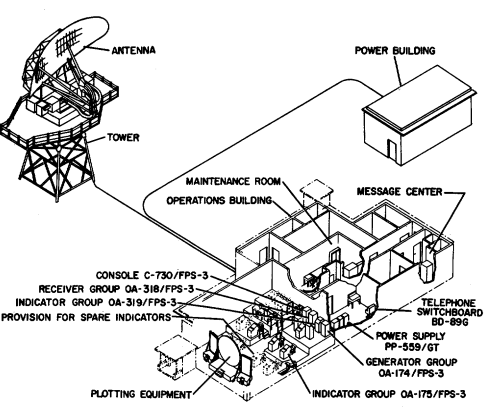
The ability of radar to distinguish between targets that are very close in either range or bearing is known as “range resolution.” When the two “blips” merged on the radar scope, that simply means the two craft were close enough that the radar could not distinguish between the two. Technical documents tell us that the range resolution for the AN/FPS-3 radar set was ½ mile. So the two aircraft would have merged on the scope once they were within half a mile of each other, at an absolute minimum. The scope itself could also provide another additional source of resolution loss. That is a significant enough distance that makes it difficult to assume any particular course of events happened within the small window of time after the blips merged and the IFF indicator disappeared off the radar scope.

It is important to note that the altitude readout on the operator’s display would have come from the separate height-finder antenna which could only be trained on a single target at a time. This is notable because the radar scope would not indicate if one of the targets suddenly nose dived into Lake Superior as it would have been trained at the specific altitude of the bogey. [This is an assumption we are making based on our second hand knowledge of this radar equipment and procedures. Further research is needed to verify this claim].

Another potentially useful consideration is radar shadow. Radar shadow is the area between the earth and the lowest radar level possible. Effectively, radar can’t see past the curvature of the earth. This normally isn’t a problem, but at low altitudes and long distances, it can become one. In this case, using the known “altitude” of the RADAR equipment and the distance to the last known location of the fighter jet, we can calculate the radar shadow beginning at 1000 ft above Lake Superior. This leaves a small possibility that the jet could have had engine failure or dived to miss the C-47 and never diverged from within the ½ mile range resolution while above the 1000 ft altitude necessary to remain on radar. If they landed on the Lake after engine failure, it is also important to note that their radios would not have been able to reach any GCI stations. They only would have been able to talk to other aircraft in the area.
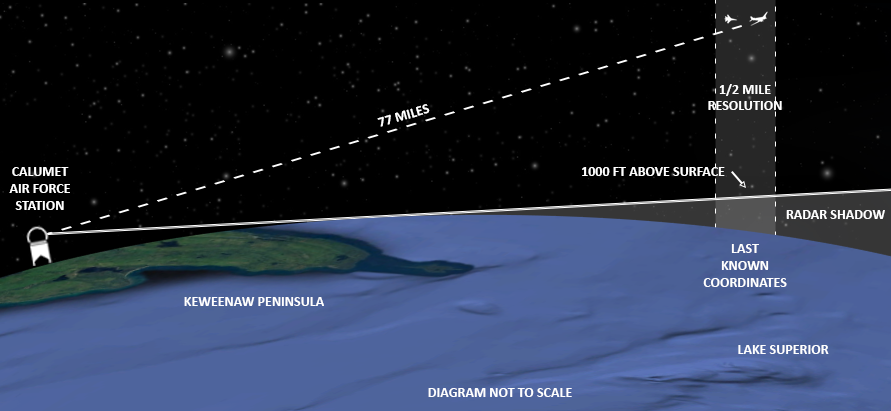
CONCLUSION
In summarizing our investigation into the Kinross Incident, it's clear that this event remains a significant yet unresolved part of Cold War and aviation history. The disappearance of the U.S. Air Force F-89C Scorpion jet on November 23, 1953, with crew members First Lieutenant Felix Moncla Jr. and Second Lieutenant Robert Wilson, is still unexplained.
The various theories about the jet's fate stem from the absence of conclusive evidence. Despite comprehensive search and rescue efforts, no definitive answers were found. The investigations were detailed but could not determine what happened that night, leading to continued speculation.
One plausible theory is mechanical failure leading to a crash, given the F-89C Scorpion's known issues. The Air Force documents generally align with other information from that era. However, if Donald Keyhoe's reported conversations are accurate, it raises the possibility of an Air Force cover-up, suggesting there might be more to the story.
Media and popular culture have played a significant role in shaping the narrative of the Kinross Incident, sometimes sensationalizing it, as seen in the false 2006 claim about finding the wreckage. This underlines the ongoing interest in the case.
Overall, the Kinross Incident highlights the technological and knowledge limitations of the mid-20th century. It remains a subject of interest and conjecture, emphasizing the importance of thorough, evidence-based investigation in historical events. The complete story behind the disappearance of the F-89C Scorpion and its crew is still unknown, and we hope that one day this mystery will be resolved.
Our research into this incident has been extensive, yet we continue to seek more information and will update this article with any new findings.
RESEARCH AND SOURCES
There is a lot of information available online, in books, and even in a few TV shows and documentaries regarding the “Kinross Incident”. However, the details vary drastically between these different sources and often provide very few references. Due to the nature of this event, the amount of time that has passed, and the complete lack of any confirmed wreckage, there has been a lot of room for speculation, embellishment, and misinformation.
While we looked at every available source we could find while researching this article, most of the details come directly from the official USAF Aircraft Accident Investigation Report. This report included written statements from multiple personnel involved in the events of November 23 and the Search and Rescue operations over the following days, and the subsequent investigation. These statements were used to piece together the detailed timeline included in this article from multiple different perspectives.
Research about the F-89 model of aircraft, including details about its history of mechanical issues, comes primarily from the Encyclopedia of US Air Force Aircraft And Missile Systems: Volume 1 by Marcelle Size Knaack, Office of AIr Force History published in 1978. A digital copy is available from the Department of Defense here.
An incredible amount of useful information has been pulled from the various unit reports we have requested from the USAF Archives. These include:
4706TH DEFENSIVE WING 1 JULY TO 31 DEC 1953
520TH AIR DEFENSE GROUP @ TRUAX FIELD
534TH ADG @ KINROSS AFB
665TH AC&W @ CAFS
We have collected a large number of newspaper articles from the days following the disappearance of the F-89. Most tell pretty similar stories and don’t include a lot of details, but they do help confirm that some of the misinformation and conflicting information was not part of any initial reports on the incidents. Incorrect details such as the unknown aircraft being near the Soo Locks are never mentioned once.
The Accident Investigation Report, newspaper articles, and other supporting documents are all available in a publicly accessible Google Drive here:
https://drive.google.com/drive/folders/1kWBgn3hf5jTFz4EkLd-qU0IUgrkXuxN7?usp=drive_link
FURTHER READING
Interested in reading more about this incident and doing your own research? These are some of the sources we started with in our search.